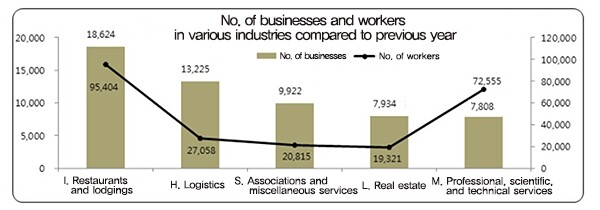hankyoreh
Links to other country sites 다른 나라 사이트 링크
S. Korea sees significant rise in number of coffee shops and hair salons

South Korea saw a major increase in the number of coffee shops and hair salons doing business last year. The logistics industry also appears to be expanding as more customers buy products online.
According to tentative businesses figures from 2018 released by Statistics Korea on Sept. 26, there are 4,102,540 businesses around the country, representing a year-on-year increase of 2.1% (82,668). There were 22,195,082 workers, which was also up by 2.6% (568,178). Over the past 10 years (2008-2018), the number of businesses has increased by an annual average of 2.3%, and the number of workers by 3.1%.
The number of businesses has increased in all industries except for mining. There were 766,201 restaurants and lodgings, an increase of 2.5% (18,624) over the previous year. A large part of that increase consisted of coffee shops, with 9,648 new businesses pushing the total up 16.9% to 66,576. The number of coffee shops has risen by 29% (15,025) since 2016 (51,551), when Statistics Korea began tracking that category of business separately.
The industry that saw the most growth after restaurants and lodgings was logistics (40,144), which was up by 3.4% (13,000). The category of associations and miscellaneous services (41,772) also rose by 2.5% (10,000), largely fueled by nail shops, hair salons, and massage parlors. Statistics Korea attributed the growth in the logistics industry to increased online shopping, which has boosted demand for logistics and delivery.
The professional, scientific, and technical industry (112,059), which includes business consulting and advertising agencies, rose by 7.5% (7,808), while the real estate industry also saw major growth, rising by 5.2% (7,934) to a total of 160,017 businesses. In contrast, the number of businesses in the manufacturing industry only increased by 3,162 (0.7%) to 436,846. The situation was similar in the wholesale and retail industry (1,028,107), where the number of businesses inched up by 0.5% (5,368).
In terms of the number of workers, the restaurants and lodgings industry grew by 95,000, the health and social work industry by 87,000, and the professional, scientific, and technical industry by 73,000. In contrast, workers in the financial and insurance industry declined by 16,000.
When businesses are ranked by the size of their workforce, businesses with 1-4 employees edged down by 0.5% (47,074) from the previous year to 3,275,276. Businesses with 5-99 employees increased by 0.5% (35,470) to 88,359. The number of companies with 100-299 employees (14,844) and the number with 300 or more employees (4,061) remained nearly the same as the previous year.
In terms of the age of business owners, the largest cohort was people in their 50s, but the cohort in their 60s or above exhibited considerable growth. There were 927,194 businesses in which the owner was at least 60 years old, up 6.4% (55,574) year on year. There were 1,417,253 businesses with a 50-something owner, an increase of 1.3% (17,573), and 103,888 businesses with an owner below the age of 30, up 2.2% (2,215). The aging of Korean society is one of the factors driving up the number of businesses run by senior citizens. That figure has increased by a yearly average of 7.5% since 2013, when it was tallied at 627,344.
By Lee Kyung-mi, staff reporter
Please direct comments or questions to [english@hani.co.kr]

Editorial・opinion
![[Editorial] Yoon must halt procurement of SM-3 interceptor missiles [Editorial] Yoon must halt procurement of SM-3 interceptor missiles](https://flexible.img.hani.co.kr/flexible/normal/500/300/imgdb/child/2024/0501/17145495551605_1717145495195344.jpg) [Editorial] Yoon must halt procurement of SM-3 interceptor missiles
[Editorial] Yoon must halt procurement of SM-3 interceptor missiles![[Guest essay] Maybe Korea’s rapid population decline is an opportunity, not a crisis [Guest essay] Maybe Korea’s rapid population decline is an opportunity, not a crisis](https://flexible.img.hani.co.kr/flexible/normal/500/300/imgdb/original/2024/0430/9417144634983596.jpg) [Guest essay] Maybe Korea’s rapid population decline is an opportunity, not a crisis
[Guest essay] Maybe Korea’s rapid population decline is an opportunity, not a crisis- [Column] Can Yoon steer diplomacy with Russia, China back on track?
- [Column] Season 2 of special prosecutor probe may be coming to Korea soon
- [Column] Park Geun-hye déjà vu in Yoon Suk-yeol
- [Editorial] New weight of N. Korea’s nuclear threats makes dialogue all the more urgent
- [Guest essay] The real reason Korea’s new right wants to dub Rhee a founding father
- [Column] ‘Choson’: Is it time we start referring to N. Korea in its own terms?
- [Editorial] Japan’s rewriting of history with Korea has gone too far
- [Column] The president’s questionable capacity for dialogue
Most viewed articles
- 1Months and months of overdue wages are pushing migrant workers in Korea into debt
- 2[Guest essay] Maybe Korea’s rapid population decline is an opportunity, not a crisis
- 3Dermatology, plastic surgery drove record medical tourism to Korea in 2023
- 4Under conservative chief, Korea’s TRC brands teenage wartime massacre victims as traitors
- 5At heart of West’s handwringing over Chinese ‘overcapacity,’ a battle to lead key future industries
- 6Trump asks why US would defend Korea, hints at hiking Seoul’s defense cost burden
- 7First meeting between Yoon, Lee in 2 years ends without compromise or agreement
- 81 in 3 S. Korean security experts support nuclear armament, CSIS finds
- 9[Editorial] Yoon must halt procurement of SM-3 interceptor missiles
- 10Fruitless Yoon-Lee summit inflames partisan tensions in Korea